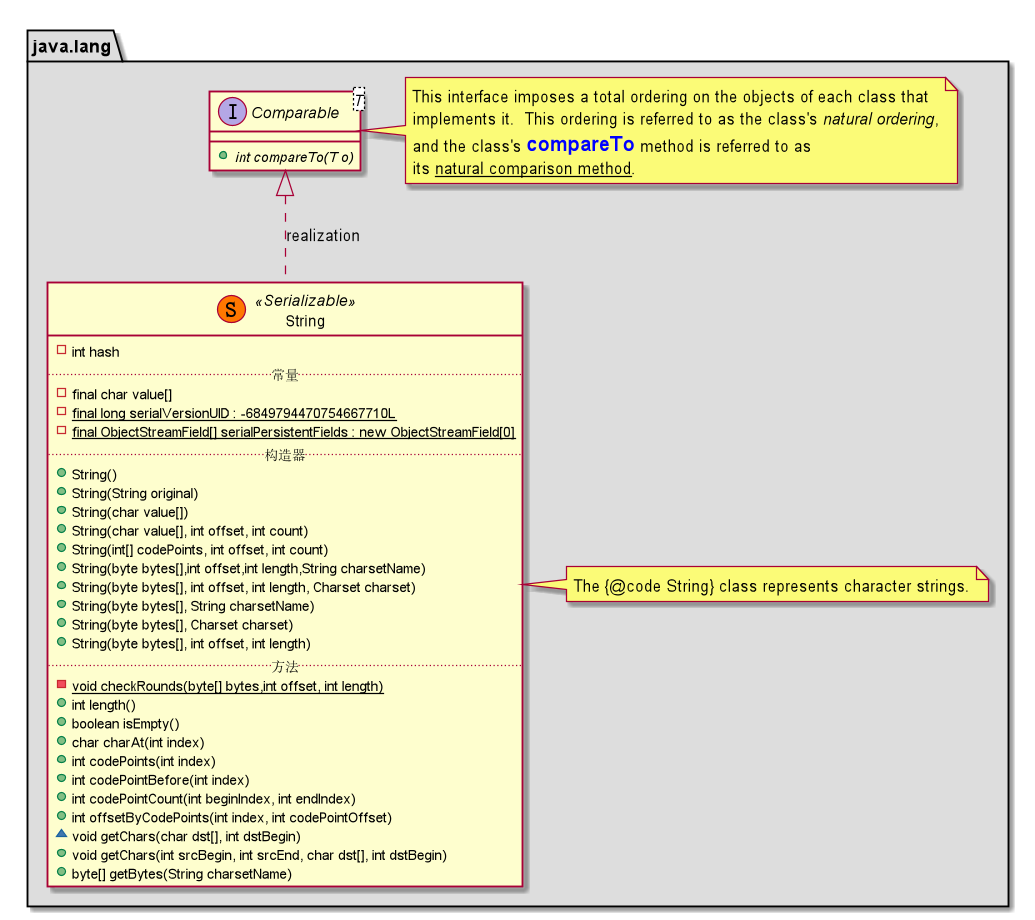UML基础介绍
UML(Unified Modeling Language)统一建模语言,是一种用于软件系统分析和设计的语言工具,他用于帮助软件开发人员进行思考和记录思路的结果。
UML图的分类
- 用例图
- 静态结构图:类图、对象图、包图、组件图、部署图
- 动态行为图:交互图、状态图、活动图
安装PlantUML插件及Graphviz软件
- PlantUML插件
- 图像可视化的软件Graphviz
- 在IntelliJ IDEA中搜索并安装PlantUML,重启idea;
- 下载安装graphviz,并配置环境变量
GRAPHVIZ_DOT=D:\Program Files\Graphviz2.38\bin\dot.exe
绘制类图
类之间的关系
- 依赖关系
- 类中用到了对方
- 类的成员属性
- 方法的返回类型
- 方法的参数类型
- 方法中使用到
- 泛化关系
- 实现关系
- 关联关系(类与类之间的关系)
- 聚合关系(整体与部分,导航性,关联关系的特例,可分离)
- 组合关系(整体与部分,不可分离,共生共灭)
可以在符号中的-或者.间添加up、down、left、right来改变类关系连接线的方向
| Type | Symbol |
|---|---|
| Generalization(泛化) | <|– |
| Realization(实现) | <|.. |
| Dependency(依赖) | <.. |
| Association(关联) | – |
| Aggregation(聚合) | o– |
| Composite(组合) | *– |
可以在关系语句后面通过:来添加类之间关系的说明
@startuml
class1 <|-- class2
class3 <|.. class4
class5 <.. class6
class7 -- class8
class9 o-- class10
class11 *-- class12
@enduml

添加属性和方法
类型
| keyword | Description |
|---|---|
| package | 包 |
| abstract class | 抽象类 |
| interface | 接口 |
| annotation | 注解 |
| enum | 枚举 |
定义可访问性
| Symbol | Visibility |
|---|---|
| - | private |
| # | protected |
| ~ | default |
| + | public |
抽象与静态
| Symbol | Description |
|---|---|
| {static} | 静态 |
| {abstract} | 抽象 |
注释
- 注释的位置
| Symbol | Description |
|---|---|
| note left of | 左边 |
| note right of | 右边 |
| note top of | 上边 |
| note bottom of | 下边 |
- 注释中的html标签
| Symbol | Description |
|---|---|
<b> |
粗体 |
<u> |
下划线 |
<i> |
斜体 |
<s>,<del>,<strike> |
删除 |
<font color="#AAAAAA">,<font color="colorName"> |
字体颜色 |
<size:nn> |
字体大小 |
<img src=""> |
图片 |
@startuml
package java.lang #DDDDDD{
interface Comparable<T>{
+ int compareTo(T o)
}
class String << (S,#FF7700) Serializable>>{
- int hash
..常量..
- final char value[]
- {static} final long serialVersionUID : -6849794470754667710L
- {static} final ObjectStreamField[] serialPersistentFields : new ObjectStreamField[0]
..构造器..
+ String()
+ String(String original)
+ String(char value[])
+ String(char value[], int offset, int count)
+ String(int[] codePoints, int offset, int count)
+ String(byte bytes[],int offset,int length,String charsetName)
+ String(byte bytes[], int offset, int length, Charset charset)
+ String(byte bytes[], String charsetName)
+ String(byte bytes[], Charset charset)
+ String(byte bytes[], int offset, int length)
..方法..
- {static} void checkRounds(byte[] bytes,int offset, int length)
+ int length()
+ boolean isEmpty()
+ char charAt(int index)
+ int codePoints(int index)
+ int codePointBefore(int index)
+ int codePointCount(int beginIndex, int endIndex)
+ int offsetByCodePoints(int index, int codePointOffset)
~ void getChars(char dst[], int dstBegin)
+ void getChars(int srcBegin, int srcEnd, char dst[], int dstBegin)
+ byte[] getBytes(String charsetName)
}
note right of Comparable : This interface imposes a total ordering on the objects of each class that\nimplements it. This ordering is referred to as the class's <i>natural ordering</i>,\nand the class's <size:16><color:blue><b>compareTo</b></color></size> method is referred to as\nits <u>natural comparison method</u>.
note "The {@code String} class represents character strings." as N1
Comparable <|.down. String : realization
N1 .left. String
}
@enduml
